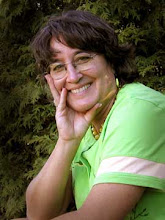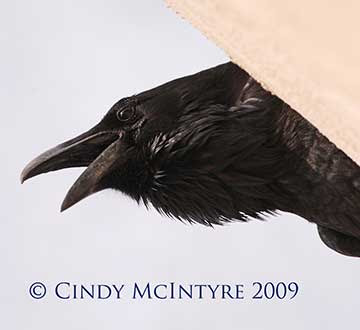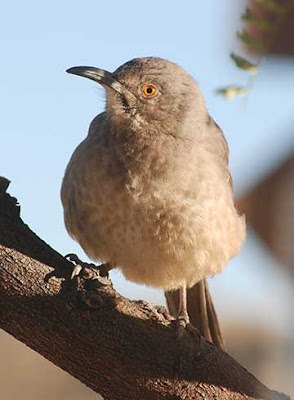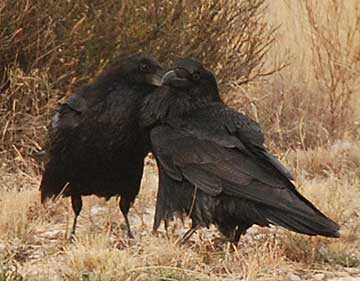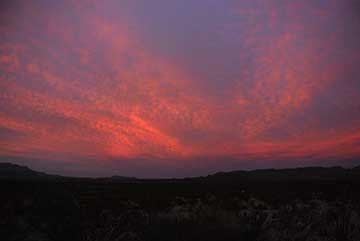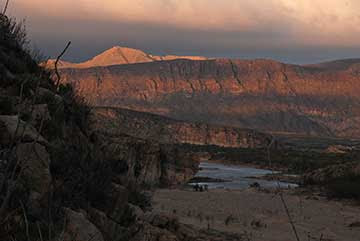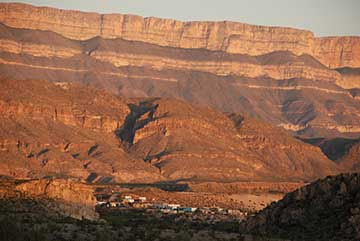
Coyote
On my drive to or from work four days a week, I usually encounter wildlife of one sort of another. Two coyotes were in the road once, and three times now I've seen the coyote with an injured back leg scamper into the brush. Last night (Dec. 19) a gorgeous mule deer 6-point was ambling across the road, completely oblivious to my headlights, and if I hadn't braked he would be venison. At some point he came out of his reverie, realized he was in danger, and bounded away.
Jackrabbits and cottontail bunnies, javelinas, deer, and various birds often feed at the roadside where the grass is more lush. Twice at the entrance station I heard a faint but haunting melody of coyote song in the distance, a weird cacophony of yelps, howls, and barks. Pure wilderness.
There was a rattlesnake in the maintenance shed before I arrived in the park. I've yet to see any snakes at all here, and I've only seen two tarantulas in the housing area. I haven't had the courage to pick them up, although I know they are sold as pets (maybe a different species) and rarely bite. At home in Maine I won't kill a spider. I pick it up with a tissue and, like Pee Wee Herman rescuing the snakes from the burning pet store in "Pee Wee's Big Adventure," I scream "EEEEEEEE" all the way outdoors. The tissue and spider both land outside, lest the creature actually crawl on me. Spiders are good, I tell myself. They won't hurt me. Eeeeeee!
Out here in the Texas desert, brown recluse and black widows could be lurking, and those I would kill if I saw them, as they are poisonous. As a kid growing up down South, I learned to turn my shoes over and shake them to dislodge any brown recluse that might be lurking there. It's an OCD habit I have to this day.
At the Taco Stand, the canyon towhees and rock wrens sometimes glean dead bugs from my van's fender and wheel wells when I arrive in the morning. Reminds me of those birds that pick ticks off the backs of rhinos in Africa. Glad I could be of service, little ones.
We also have the resident ravens, which Doug has named George and Gracie, and Gary calls Heckle and Jeckle. (You'd have to be people of a certain age to know both sets of characters.)They usually pay a visit mid-afternoon, with one sitting on the roof and croaking at me, as if to say "don't you have any goodies for us today?" Uh, no feeding the wildlife, remember?
"That's right, women are smarter. Smarter than a man any day" - C. J. Chenier
And strangest of all, we have the locoweed birds. Those are the ones, males all, who continually bash their reflections in the visitor center windows. They all think it's another male in their territory, and will go on for fruitless weeks with this. The resident curve-billed thrasher, who I named Locoweed, particularly loves the west-facing picture window in early evening, protecting his Missus from the invincible intruder. I think the thrasher taught the cactus wren how to do this, too, as I saw him watching Locoweed curiously one evening. The next day Mr. Wren was in on the act, too, "thrashing" away at the audacious duplicate, teacher and student side-by-side.
One day, after I had finished up and sat in the visitor center watching the sun go down behind the distant mountains, Locoweed was doing his thrasher thing when the Missus flew to the ledge beside him. Their sweet cooings and chatters went on non-stop, and she had a calming effect. Occasionally he'd make a feeble stab at the "intruder" and she'd give him a little peck as if to say "Grow up, Dodo Head." They appeared as if they would roost right there for the night. It seemed rather exposed should a great horned owl come prowling. But what do I know? They were still cooing to each other when I turned on the alarm and left.
Last week a coyote sauntered lazily past the Taco Stand (photo at top of blog) and up the road, and several days later I saw him in the visitor center parking lot. We haven't seen Locoweed the crazy curve-billed thrasher lately, so I hope he didn't become the coyote's meal.
Doug once videotaped a roadrunner bashing himself against the front door. Its long tail wagged to and fro in its frenzy, making a comical scene. Somehow I can't see the Warner Brothers Roadrunner acting that silly.
Here are some photographs a roadrunner behaving properly.
More critter updates as they become available.
